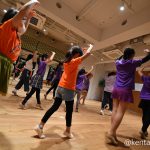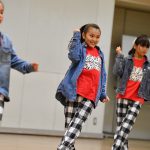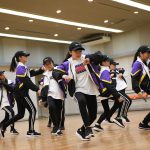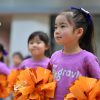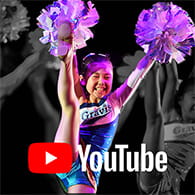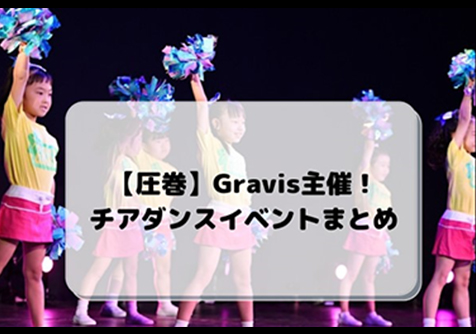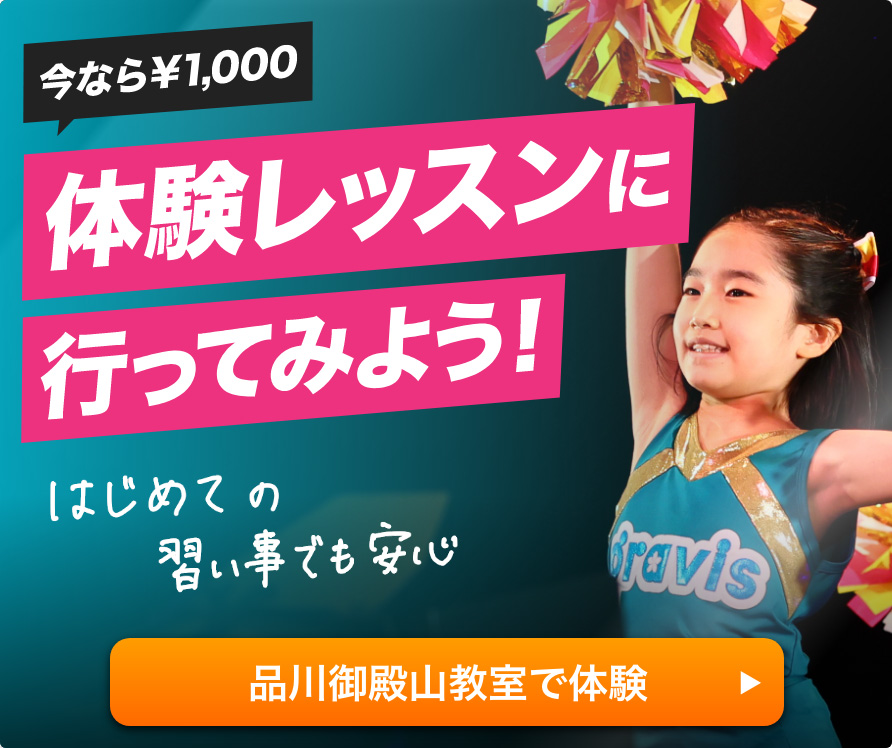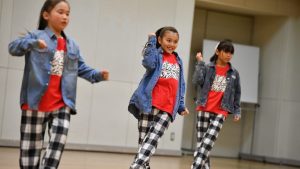
Hello everyone looking for kids’ dance classes in Manhattan area!
In this article, we’ll introduce kids’ dance schools in Manhattan area that accept students starting from preschool age.
目次
- 1 3 Kids’ Dance Schools in Manhattan Area
- 2 Where Do Students Come From?
- 3 Frequently Asked Questions About Dance Lessons
- 4 Are you familiar with the popular dance style called Cheer Dance?
- 5 Summary
3 Kids’ Dance Schools in Manhattan Area
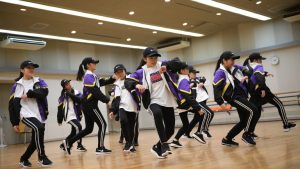
Here’s a summary of kids’ dance schools in Manhattan area that accept preschool-aged children!
Gravis New York – Manhattan Cheer Dance Classes
Gravis offers cheer dance classes for children, including preschoolers, with over 150 locations mainly in Tokyo and Kanagawa!
With around 2,500 students enrolled, Gravis offers classes ranging from 3-year-old beginners to competition-level teams.
Our experienced instructors, who have extensive teaching experience as well as appearances in various media and awards in domestic and international competitions, provide thorough and accurate guidance from the basics to advanced cheer dance techniques.
Gravis opened its second U.S. location in New York, following its U.S. debut in Torrance, Los Angeles, in February 2024!
The studio is a 7-minute walk from 34th St–Penn Station.
| Schedule |
CHEER HIP-HOP |
| Age Group | Preschool – 5th Grade |
| Fees |
Trial Lesson: $10 Enrollment Fee: Free Monthly Tuition (Preschool – 5th Grade): $170 |
| Access | 16th floor 520 8th Ave New York NY 10018 |
Gravis New York – Queens Cheer Dance Classes
Gravis offers classes at over 100 locations, mainly in Tokyo and Kanagawa.
With around 2,500 students enrolled, we provide programs ranging from 3-year-old beginner classes to competition-level teams.
Our experienced instructors, who have appeared in various media and won awards in domestic and international competitions, teach cheer dance thoroughly and accurately, from the basics to advanced techniques.
Following our U.S. debut in Los Angeles, Gravis has expanded to New York!
The studio is a 5-minute walk from 33rd Street–Rawson Station.
Lessons are available in both Japanese and English!
Why not start cheerleading in the U.S., the home of cheer, as an extracurricular activity for your child?
Petit Allongé Bella BALLET SCHOOL
Petit Allonge Bella NY is a ballet school dedicated to nurturing the human spirit through the art of ballet.
Where Do Students Come From?

Manhattan is very accessible by public transportation, so students come from many different areas, including Brooklyn, Queens, Port Washington, Yonkers, and New Jersey.
If you’re unsure which school to choose, consider these points: whether classes are offered at your preferred time, how well your child gets along with the instructor, and the school’s track record.
Frequently Asked Questions About Dance Lessons
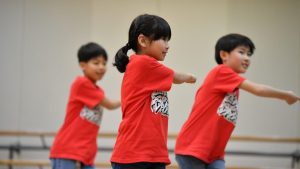
You might be thinking about starting dance lessons, but questions like “What’s the best age to start?” or “How much does it cost?” can cause some concerns.
From here, we’ll go into detail to help clear up those worries and give you the information you need!
What Are the Benefits of Learning Dance?
In the field of developmental psychology, the positive effects of dance on children’s brains are attracting attention.
Through dance, children can fully express their natural desire to “move” and “play,” while also developing essential life skills such as self-control, self-expression, communication, and resilience.
In Japan, the national curriculum guidelines are revised every 10 years. In the latest revision, the focus is not only on what children learn, but also on how they learn and what they are able to do as a result. The goal is to foster children’s “zest for living” in a holistic way.
Dance was added to school physical education classes because it helps enhance this very “zest for living.”
Additionally, the physical education curriculum highlights the development of coordination skills, which consist of the following seven abilities:
①Differentiation ability (control of objects and body movements)
②Orientation ability (awareness of space, distance, and timing)
③Adaptability (quickly switching movements depending on the situation)
④Reaction ability (responding quickly to signals or cues)
⑤Rhythmic ability (moving in sync with timing and rhythm)
⑥Balance ability (maintaining physical stability)
⑦Coupling ability (coordinating the whole body smoothly)
These coordination skills are not only useful for dance but also for other sports, communication, and even academic performance.
At Gravis, many parents have shared their experiences, saying things like:
-
“My child’s athletic ability has improved.”
“They’ve become less shy.”
“They don’t give up easily anymore.”
What Age Can Children Start Learning Dance?
The starting age for dance lessons depends on each school and class, so it’s best to first check the school’s website for age requirements or contact the school directly.
At Gravis, classes are available starting from preschool age (3 years old as of April 1).
From the perspective of brain science, different areas of the brain reach their developmental peaks at different times, and it’s said that starting lessons around age 3 is highly recommended.
Generally, children experience rapid growth in motor skills between ages 9–12, known as the “Golden Age”—a period when learning new movements is at its peak. The years 4–8 are referred to as the “Pre-Golden Age.”
During this Pre-Golden Age, it’s especially effective for children to try different types of physical activities, discover what truly interests them, and find something they can be passionate about.
That way, by around age 9, they can dive into more focused training with a strong foundation already in place.
How Much Does It Cost to Take Dance Lessons?
The main costs involved in children’s dance lessons typically include:
-
Initial fees (such as admission or registration fees)
Lesson fees (monthly tuition or class tickets)
Performance fees (for recitals or showcases)
As a general guide, the monthly tuition for a dance school is usually around $100–$200.
When it comes to recital or performance costs, the amount can vary significantly depending on the school and the style of dance.
Common expenses may include:
-
Participation fees
Costume fees
Ticket fees (if parents are required to purchase a certain number)
In total, recital costs often range from $200 to $500.
For classical ballet recitals, however, expenses can sometimes exceed $1,000 per performance, depending on the school.
Are you familiar with the popular dance style called Cheer Dance?
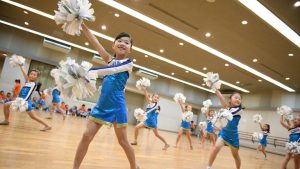
With dance now a required subject in schools, it has also become increasingly popular as an extracurricular activity for children. But did you know that there is a dance style called Cheer Dance?
In Japan, Cheer Dance gained major attention when the real-life story of the Fukui Commercial High School cheerleading team JETS, who won the U.S. national championship, was adapted into a 2017 movie starring Suzu Hirose.
It was later dramatized in 2018 with Tao Tsuchiya as the lead in the TV drama “Cheer☆Dan.”
Thanks to this growing attention, more and more children are now joining kids’ cheer dance schools and classes!
What is Cheer Dance?
So, what exactly is cheer dance?
Cheer dance is a sport that originated from cheerleading. In the United States, it is recognized as an independent sport and is often called Pom Dance or simply Dance.
Interestingly, the term “Cheer Dance” itself was actually created in Japan.
In cheer dance, dancers perform a routine of about two minutes that combines three styles: Pom Dance, Hip Hop, and Jazz Dance.
If you’d like to learn more about cheer dance, check out What kind of dance is cheer dance?
The Difference Between Cheer Dance and Cheerleading
Cheerleading is said to have originated about 100 years ago at American universities, where students cheered for their school football teams. (In the beginning, it was actually a form of vocal cheering led by male students.)
The style we see today, featuring female dancers, was established around 30 years ago.
Cheerleading is a sport that mainly focuses on acrobatic skills, such as stunts (pyramid-style lifts) and tumbling (floor gymnastics).
Cheer dance, on the other hand, developed by separating the dance element from cheerleading.
In competitions, teams perform a two-minute routine that combines Pom Dance, Hip Hop, and Jazz Dance, showcasing unity, energy, and expressive performance.
What both cheerleading and cheer dance share in common is the “Cheer Spirit”—the idea that anyone who practices either is called a “cheerleader.”
While there are many interpretations of Cheer Spirit, the Japan Cheer Dance Association defines it as “always cheering for others with a smile and lifting people up with positive energy.”
If you prefer graceful movements over acrobatic skills, cheer dance might be the perfect choice for you!
What are the benefits of taking cheer dance lessons?
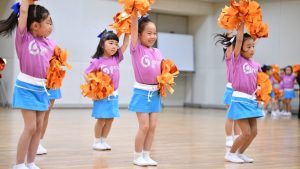
What can you learn from cheer dance among the many dance genres? What are its benefits?
One key difference between cheer dance and other dance styles is that you develop cheer spirit!
Cheer spirit can be interpreted in various ways, but according to the Japan Cheer Dance Association, which organizes nationwide cheer dance competitions in Japan, it is defined as: “always encouraging and energizing others with a smile.”
Here’s a closer look at what Gravis values, which aligns with this cheer spirit.
① Learning Greetings, Responses, and Manners
The word “Cheer” in cheerleader means to support or encourage, and “Leader” means instructor or guide.
To lead others (by being a role model), children are encouraged to take initiative in greetings, responding politely, and everyday actions.
This allows them to practice manners in real situations, more effectively than in typical preschool classes.
② Learning Smiles, Energy, and Expression
To support others, children first learn the importance of smiling themselves.
By performing cheerfully, their energy and smiles create a “chain of smiles,” making the audience and parents happy.
At cheer dance competitions, unlike most sports or dance competitions where participants see each other as rivals, cheer teams actively cheer for other teams from the audience!
While final rankings are given, each team encourages others respectfully so everyone can showcase their hard work.
③ Learning Cooperation and Teamwork
Cheer dance is a team sport.
Performances are not done alone, so children naturally develop the ability to communicate and cooperate with friends and instructors.
By sharing each member’s strengths and weaknesses, supporting each other in both technical and mental aspects, children grow empathy and a sense of community while completing their routines.
④ Developing a Challenging Spirit
As mentioned earlier, a single cheer dance routine combines three dance genres: pom dance, hip-hop, and jazz dance.
In Gravis lessons, children learn all three: pom dance with pom-poms, hip-hop with low-center movements, and jazz dance with lifted movements (including ballet basics).
To master these different styles, children are encouraged to try new moves without fear of failure, fostering a strong willingness to challenge themselves.
If you’re interested in Gravis cheer dance classes, check out the official website!
What age can children start?
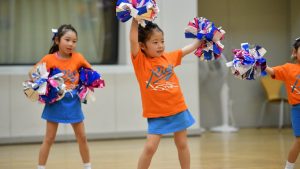
Cheer dance classes also have different rules depending on the school!
At Gravis, classes are open to preschool children (age 3 as of April 1) and up.
In general, lessons are conducted without parents present, so this age requirement helps ensure the children’s concentration and safety.
Unlike daycare or preschool, a dance school is primarily a place to learn “dance.”
Of course, through dance lessons, children also learn valuable life skills such as greeting others, responding politely, preparing for class, and cooperating with friends.
However, it’s best for children to be able to manage basic self-care tasks, like using the restroom independently, before joining.
This way, both children and parents can focus on enjoying and learning dance safely and confidently.
Where Should You Go If You Want to Learn Kids’ Cheer Dance?
Kids’ cheer dance schools (classes) can be broadly divided into three types, depending on the purpose—such as “where you’ll perform” or “what you want to aim for.”
①Schools Where You Can Take Cheer Dance Classes
If you’re just starting out and want to learn cheer dance as your first extracurricular activity, a school specializing in cheer dance, a large sports gym, a cultural center, or a dance school with cheer dance classes is perfect!
In lessons, children learn the basics of cheer dance, including body conditioning, arm motions (unique cheer dance movements), techniques (turns, jumps, etc.), and choreography.
Some schools also offer opportunities to perform at recitals, competitions, or local events.
- If you just want to enjoy learning cheer dance
- If you want to learn the basics of cheer dance
- If you like moving your body
…then look for a nearby cheer dance school or check if sports gyms, cultural centers, or dance schools in your area offer cheer dance classes.
②Club Teams
A club team is a type of organization run not by a company but by a group of enthusiasts who organize and manage it themselves.
Cheer dance can be roughly divided into competitive cheer and cheering for sports.
Club teams mainly aim to compete in cheer dance competitions hosted by organizations such as the Japan Cheer Dance Association or CHEER&DANCE Education.
Competitions bring together teams from all over Japan, where performance and technical skills are judged.
Top-level teams can even earn the right to compete in world championships.
To aim for high ranks in competitions, teams practice not only basic skills but also advanced techniques, requiring both technical ability and mental strength. Training can sometimes be intense.
Because club teams are self-managed, operational costs and cooperation from parents are often necessary, which can mean a greater commitment for families.
- If you want to aim for a high level in cheer dance
- If you want parents to be actively involved
…then a club team is recommended.
③Sports Team-Affiliated Cheer Dance Schools
Sports team-affiliated cheer dance teams are tied to specific sports teams—baseball, soccer, basketball, or football—and focus on learning performance for sports cheering rather than competing in competitions.
Students learn to lead cheers, energize the crowd through performances, and support their own team.
Performance styles vary depending on the sport, team, and venue, so look for cheer teams affiliated with sports you like or local teams in your area.
- If you love sports
- If you want to cheer for sports events
…then a sports team-affiliated cheer dance team is perfect!
Recently, many schools—including Gravis—have both competitive teams for competitions and cheering teams for sports events within a single cheer dance school, separating teams based on their goals.
How Much Does It Cost to Take Cheer Dance Lessons?
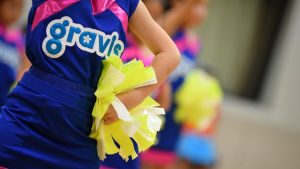
The main costs associated with taking cheer dance lessons include:
①Lesson Fees
・Trial lesson fee for first-time students
・Initial costs (registration fee, administrative fees, etc.)
・Monthly tuition or class passes
②Costume and Equipment Fees
・Pom-poms
・Costumes or uniforms
・Shoes
③Event and Performance Participation Fees
・Fees for local events
・Fees for recitals or showcases
The overall cost of cheer dance lessons varies depending on the school or studio, but it’s generally comparable to regular dance classes (with average monthly tuition around ¥5,000–10,000).
Initial fees and monthly tuition are often listed on the school’s website, so it’s a good idea to check in advance. Participation fees for recitals or events and costume costs may vary each year, so total expenses can fluctuate.
For a detailed breakdown of actual costs at Gravis Cheer Dance School, you can refer to our article on “Benefits and Costs of Cheer Dance for Children.”
Summary
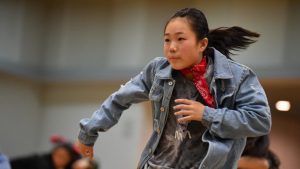
Did any of the dance schools catch your eye?
This time, we introduced kids’ dance schools in Manhattan area that accept children from preschool age!
If you’re interested in Gravis’ cheer dance classes, be sure to join a trial lesson or come for a visit.
Our experienced instructors are looking forward to meeting you!
We hope you find the perfect kids’ dance school and a fun activity that’s just right for you☆
Related Articles
ニューヨークエリアのキッズチアスクール(教室)まとめ
Gravisニューヨークチアダンスクラス情報!メンバー募集中!
チアダンスって、どんなダンス?
いま大注目のキッズチアダンスについて徹底解説します!
初めての習い事選び~どんな効果を求めますか?~
【子どもの習い事】ダンスにする?チアダンスにする?
【子どもの習い事】チアダンスを習うメリットと費用の詳細をご紹介!
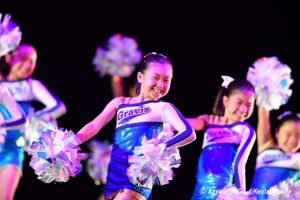
Gravis YouTube Channel
👉 [Gravis Dance & Fitness – YouTube]
Please subscribe to our channel ☆
📩 Email: office@gravis-dance.com
☎︎ +81-50-3131-1065 (Japan line)
Instagram: @gravis_dance_fitness
Facebook: @gravisdancefitness
Twitter: @Gravis_Dance


